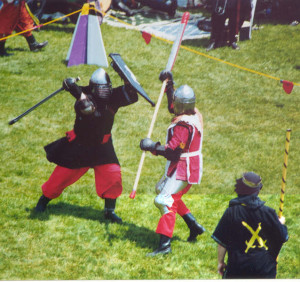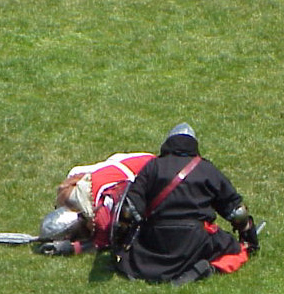This article originally appeared in the Yule 1994 issue of Idunna, the journal of the Ring of Troth.
It was also submitted as the first research project in my Elder training in the Ring.
Of all the Aesir, Tyr is among the least understood. This is due to the scarcity of material from early pagan times, and due to the misconceptions and contradictions present in much of the material that is available.
From his beginnings as Tiwaz, the sky god of the early Indo-Europeans, to his remembrance as the Viking god of the thing and of warfare, to his place in Asatru today, this article will attempt to give a greater understanding of this enigmatic god.
The name Tiwaz, in Germanic, means “Shining One” or is also a generic term for “god” (Daly 1991). In Old High German, this became Zio, and in Old Norse, Tyr. The word Tiwaz is the cognate to the Sanskrit word “dyaus”, the Greek “Zeus”, and the Roman “Jupiter”. Each of these terms relates to a divinity which is the personification of the sky (Grimm 1882).
Under the name of Ziu, Tyr was the chief diety of the Suebians (Guerber 1895). The Suebians were an early Teutonic tribe, and were a part of the Alemanni who were a confederation of peoples of the Upper Rhine around the third century C.E. (Spence 1985). The modern German city of Augsburg was the Suebian capital, and was then called Ziusburg.
The wide-spread worship of Tyr throughout Northern Europe is indicated by the abundance of place-names (Tisvelde, Tysting, Tisdorf, Ziesburg etc.) and plant-names (Tyviër, Tyrhialm, Tysfiola, Tistbast etc.) which are found (Grimm 1882). These names can be found throughout the Rhine region, Upper Germany, North Germany, Saxony, and Scandinavia (MacCulloch 1930). It must be noted however, that the largest number of these place-names are concentrated in Denmark (Jones 1984).
His worship may have been even wider-spread than is indicated by these names, as other nations knew him by different names, many of which may now be lost. We do know that he was worshiped by the Saxons as Saxnot, or “Sword Companion”, and by the Cheruski under the name of Cheru. Other names under which he was worshiped include: Dings, Dis, Ear, Erias, Iertac, Ziumen, and Ziuwari (Sykes 1965). The Romans recorded his name as “Mars Thingsus”, which indicates that they perceived him as both a war god, and the god of the Thing, or assembly. This will be discussed shortly.
Probably the greatest indicator of his importance both in ancient, and even into modern times, is that one of the days of the week bears his name.
Some of what we know about the ancient importance of Tyr is contained in archaeological finds throughout Northern Europe. A set of golden runic horns were found in Gallehus, Denmark, which date to the early fifth century C.E.. These were destroyed by thieves during the 19th century, but they had been extensively studied before this occurred. Carvings on these horns depicted several figures, which have been interpreted to be either gods or godar. One of these is a one-handed man which some scholars have interpreted to be Tiwaz. Another find is a helmet plate from a Vendel grave in Sweden, which dates to the sixth or seventh century C.E.. This plate depicts a chained animal, which may represent the binding of Fenris (Davidson 1967). Proof that Tyr’s worship was carried abroad is found in the form of a Frisian altar found at Hadrian’s Wall in England in 1883 (Kauffmann 1903). The altar bears an inscription to Mars Thingsus, and was apparently used by Frisian mercenaries in service to Rome.
More reliable information than archaeological conjecture can be found in the written accounts of historians from that period, such as Cornelius Tacitus. Tacitus recorded much about the lives and religious practices of the Teutonic tribes in his Germania. The holy places of the early Germans were woods and groves (Tacitus 1970). The Suebians had a particularly holy grove in which human sacrifices were conducted. No man could enter the grove until he had been bound, to show his mortal inferiority. If someone fell while in the grove, they were not permitted to rise, but had to roll or crawl on the ground. This grove was considered to be the center of their entire religion.
By the time of the Viking era, Tyr’s importance had greatly diminished (Davidson 1988). In most areas, he was still considered to be one of the three primary gods, along with Odhinn and Thorr, but in some regions, especially Sweden, Freyr had superseded him in importance. He had come to be considered the son of either Odhinn, or the giant Hymir (Grant 1990). It is debated whether or not this was thought to literally be true, or to be simply an acknowledgment that Odhinn was now superior. It has been noted that Odhinn appears to be the successor of both the earlier Wodan, and Tiwaz, as he retained some of the qualities of both earlier dieties (Davidson 1964). The only other proposed origin for Tyr was that he was formed in Ymir’s sweat, along with the etins (Allardice 1991).
Even though his importance had diminished from earlier times, Tyr was still called on for help in battle. In the Prose Edda, (trans. Young 1954), we read:
He is the boldest and most courageous,
and he has the power over victory in
battle; it is good for brave men to
invoke him. …[he] is one-handed and
he is not called a peace-maker
Concerning the way in which he should be invoked, we find in the Lay of Sigrdrifa in the Poetic Edda (Hollander 1962):
Learn victory runes if thou victory wantest
and have them on thy sword’s hilt
on thy sword’s hilt some, on thy sword’s guard
some, and call twice upon Tyr.
This brings to mention the “T” rune that bears Tyr’s name. It was carved on weapons to insure their wielder victory. Its form has been interpreted to mean either a spearhead, or more esoterically, the vault of the heavens being supported by the universal world column (Thorsson 1984).
Besides being considered the god of battle, Tyr was also considered to be the god of law, order and justice (Davidson 1982). The dual attributes of battle and justice assigned to Tyr have caused much confusion. It is not until one considers that law transcends human definitions that this duality makes sense. In order to establish law and order within the cosmos, battle must be fought against the forces of chaos. By binding chaos, Tyr is seen as the bringer of order (Konung-Agnarsson 1994).
Understanding the transition from Tiwaz, the sky god, to Tyr, the war god, is easier when one considers that sky gods in general often have an aspect of war (De La Saussaye 1902). When one aspect of a god is removed, another will come to prominence. In this case, Odhinn and Thorr have taken over the aspect of sky god (Davidson 1982). This has left the warrior aspect as his primary role. Over time, all gods will change, depending on the attitudes and needs of their followers. This is how the law aspect came to be.
As previously mentioned, Tyr was known also as “Mars Thingsus”, or god of the Thing. The Thing was the assembly of men in which disputes were settled, laws were made, and all manner of matters decided upon. Tyr was connected with the Thing from the times of the earliest Germanic tribes. As Tacitus recorded, only the priests were allowed to mete out punishment, from floggings to death. These punishments were decided at the Thing, at first by the Godar, then in later times by the “holmganga” (trial-by- combat) (Davidson 1964). Both of these methods fall under the auspices of Tyr.
Few myths survive which tell of Tyr’s exploits. The most important of these is the binding of Fenris. For a very readable rendition of this, see _The Norse Myths_ by Kevin Crossley-Holland, or for the original, see the Prose Edda. To summarize, the gods decided that the great wolf Fenris, son of Loki, had to be bound, for fear that he would become too destructive. The gods played on Fenris’ pride, and challenged his strength to break various fetters. When the gods brought forth the magical bond Gleipnir, Fenris feared a trick, and would not let the gods place it on him until one of them placed his hand in the wolf’s mouth. Of all the gods, only Tyr was brave enough to do so. When Fenris could not break the bond, he bit off Tyr’s hand.
In the myth of Aegir’s cauldron, Tyr is no more than a straight man for Thor. For a decent rendition of this myth, see Green’s _Myths of the Norsemen_. From the myths of Ragnarok, we know what ultimate fate awaits Tyr:
Against strong Tyr leaps Garm, the fierce
wolfdog, and in dread conflict they engage;
and one by the other is wounded so that both
fall dead (MacKenzie 1985).
From the eddic sources, we see that Tyr’s actions benefit the common good. We also strengthen the concept of Tyr as a god of oaths and law. Although he broke his oath, he also willingly paid the price.
If comparatively little is known of Tyr, then almost nothing is known of Zisa, his consort. We know that she too was worshipped by the Suebians, and that a festival was held in her honor on September 28th (Grimm 1882). It is possible that Zisa is actually Isis, as Grimm draws a possible connection between the names, and Tacitus reported that Isis was revered by the Suebians. There is also possible archaeological evidence that Zisa may be a female counterpart to Tyr (Bainbridge 1993). In addition to Zisa, there is some evidence that Tyr may have been married to Angrboda, the mother of Fenris. In Loki’s Flytting (Lokasenna), Loki states: “With thy housewife I slept so a son she bore; nor did a penny didst get to pay thee back for this wrong thou wretch (Hollander 1962).”
It is necessary in a study of any depth to address the comparisons and similarities between Tyr and the gods of other folk. There are several gods that Tyr has been often compared to. The first of these is Nuada, the king of the Celtic Tuatha De Danann (MacCana 1983). There are several notable similarities between Tyr and Nuada. According to Celtic myth, Nuada lost his hand battling the Firbolgs at the first battle of Magh Tuiredh. Although the method in which each god lost his hand is different, in each case it was done to benefit the greater good of the folk. For further commentary on the nature of these losses, see _Death, War and Sacrifice_ by Bruce Lincoln.
Another point of similarity between these two are their swords. Nuada’s sword was considered to be among the greatest treasures of the Celtic gods. Similar to this is the early myth of the sword of Cheru (Tyr), which was said to have been made by the sons of Ivaldi. Cheru entrusted the keeping of his sword to his people, the Cheruski. While they held it, they believed themselves to be invincible. Legend holds that is was the sword of Cheru which Attila found and used in his conquests (Guerber 1895).
In addition to Nuada, Tyr has often been compared to Mithra, the multifaceted Indo-European god (Turville-Petre 1975). Mithra, also known as Mitra in Vedic sources, was a god of contracts and agreements, as well as serenity. It may seem to be a contradiction, but he was a peaceful god who was also capable of leading hosts to victory in battle (Comte 1991). It is also possible that the early Germans knew of Mithra, as his cult spread as far north as the Rhine, and survived into the fifth century C.E..
Works Consulted
Allardice, Pamela. Myths, Gods, and Fantasy ABC-CLIO, New York, 1991.
Bainbridge, Bill. “Tyr and Zisa” Our Troth ed. Kveldulf Gundarsson. Ring of Troth, Seattle, 1993.
Comte, Fernande. Chambers Encyclopedic guide: Mythology Chambers, Edinburgh, 1991
Crossley-Holland, Kevin. The Norse Myths Pantheon, New York, 1980.
Daly, Kathleen. Norse Mythology A to Z Facts on File, New York, 1991.
Davidson, H. R. E. Myths and Symbols in Pagan Europe Syracuse University Press, Syracuse, 1988.
—. Scandinavian Mythology Peter Bedrick, New York, 1982.
—. Pagan Scandinavia Praeger, New York, 1967.
—. Gods and Myths of Northern Europe Penguin, London, 1964.
De La Saussaye, P.D. The Religion of the Teutons Trans. B.J. Vos. Ginn, Boston, 1902.
Grant, John. An Introduction to Viking Mythology Chartwell, Secaucus, 1990.
Green, Roger L. Myths of the Norsemen Penguin, London, 1960.
Grimm, Jacob. Teutonic Mythology Trans. J.S. Stallybrass George Bell & Sons, Covent Garden, 1882.
Guerber, H. A. Myths of Northern Lands American Books, New York, 1895.
Hollander, Lee M. Trans. The Poetic Edda University of Texas Press, Austin, 1962.
Jones, Gwyn. A History of the Vikings Oxford University Press, Oxford, 1984.
Kauffman, Friedrich. Northern Mythology Trans. M. Smith Dent, London, 1903.
Konung-Agnarsson, Rig. “Tyrianism” Fjallabok May 1994: 5-7.
Lincoln, Bruce. Death, War, and Sacrifice University of Chicago Press, Chicago, 1990(?).
MacCana, Proinsias. Celtic Mythology Peter Bedrick, New York, 1983.
MacKenzie, Donald. German Myths and Legends Crown, New York, 1985.
McCulloch, John. The Mythology of All Races: Vol 2: Eddic Jones, Boston, 1930.
Spence, Lewis. Myths and Legends: Germany Bracken, London, 1985.
Sturluson, Snorri. The Prose Edda Trans. Anthony Faulkes. Tuttle, Rutland, 1987.
—. The Prose Edda Trans. Jean Young. University of California Press, 1954.
Sykes, Egerton. Everyman’s Dictionary of Non-Classical Mythology Dent, London, 1965.
Tacitus, Cornelius. The Agricola and The Germania Trans. H. Mattingly. Penguin, London, 1970.
Thorsson, Edred. Futhark Samuel Weiser, York Beach, 1984.
Turville-Petre, E. O. G. Myth and Religion of the North Greenwood, New York, 1975.
Vargr
6/16/94



